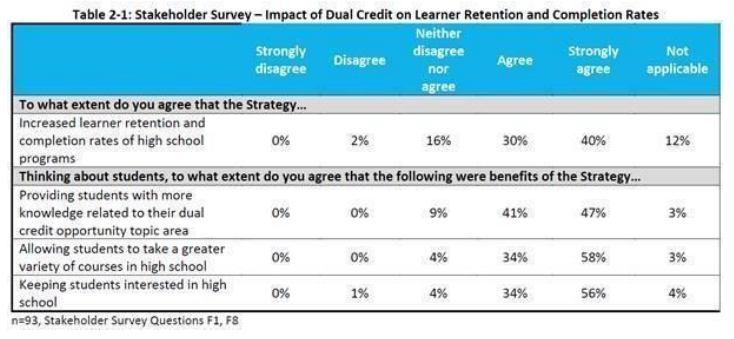Dual Credit Opportunities in Alberta (Co-Sponsored)

Dual Credit Opportunities in Alberta (Co-Sponsored)
Advanced Education - Provincial Policy
Sponsor: Lethbridge
Co-Sponsor: Medicine Hat
Issue
There is a need for the continuance of provincial investment in Dual Credit Opportunities for high school and post-secondary students to assist their transition from secondary to post-secondary education and journeyperson apprenticeship programs.
Background
The current Provincial Dual Credit Strategy Fund was approved and awarded by the Government of Alberta in 2014 for a three-year pilot project. At the conclusion of the pilot project, there had been sixty dual credit projects in the province, twenty-four of which were approved within the last round of approvals. The pilot project funding followed a number of similarly funded projects that had been supported by the government over a number of years. Dual credit funding also included targeted funding for post-secondary institutions to build capacity, establish partnerships among schools and business, and explore structures for delivery. Many colleges across Alberta have been awarded funding for the purpose of creating these educational opportunities for high school students.
The Provincial Dual Credit Strategy Implementation Evaluation prepared for Alberta Education following the pilot program provided strong indicators for expanding the program to improve student enthusiasm, confidence and excitement about moving on to post-secondary studies:

There are significant benefits to providing stable and continuous funding through the Dual Credit Strategy Fund, including supporting the labour needs of Alberta employers amidst a labour shortage.
The province has identified transition of high school students to post-secondary programs a priority and we strongly support the government in the belief that we can all work together to provide quality opportunities that prepare students for successful transition. The Dual Credit Program encourages high school students to extend their education into Alberta universities, colleges, and trade schools with the goal of encouraging growth in transition rates overall. We anticipate that this initiative will have long term positive social and business benefits for the province.
Industry partners are supporting high school students and engaging them to complete postsecondary education that is tailored to their particular industry. Students are exposed to the practical application of post-secondary studies by seeing different employment opportunities associated with the particular program, training or skill. Several Alberta Chambers of Commerce continue to take an active role in promoting Dual Credit opportunities that link students/adults and post-secondary institutions and local businesses in Southern Alberta.
There is absolutely no competition between universities, colleges, and technical trade schools as these three post-secondary tracks attract different students. A dual credit structure provides excellent opportunities for technical trade schools, colleges, and universities to work collaboratively with school divisions to effectively create attractive opportunities to students.
Presently, Alberta Education and Alberta Advanced Education are involved in the funding/approval processes. The Dual Credit Program is an opportunity for these two ministries to work collaboratively to implement a strategic and aligned process that provides increased post-secondary incentives and opportunities to high school students and young adults who wish to extend their qualifications. Truly a cross- ministry initiative, effectiveness can be enhanced with the involvement of the Ministries of Jobs, Skills, Training and Labour, Human Services, and Innovation.
The College of Alberta School Superintendents (CASS) is currently working collaboratively with school divisions and post-secondary institutions to study the advantages, the effectiveness and the possibilities within the Dual Credit program. It will take longer than three years to complete a proper longitudinal study that has the potential to produce data that supports the future of a program with this level of educational and business cooperation and integration.
The feedback regarding the benefits to youth as reported across a number of dual credit pilot projects is consistent and resoundingly positive. There is increased engagement of students in exploring education pathways, students are inspired and motivated to move forward with their education and have been able to experience firsthand both the academic context and real-world application with the business partners.
The Provincial Dual Credit Program is presently providing meaningful dialogue and collaboration between Alberta Education, Alberta Advanced Education, Alberta Labour, Alberta Human Services, CASS, school divisions, post-secondary institutions and Alberta businesses.
The Alberta Chamber of Commerce is strongly supportive of stable, continuous, stand-alone funding for the Provincial Dual Credit Strategy Fund. The province has piloted these experiences for a number of years and given the demonstrated success, it is time to build a framework and provide a seamless structure ensuring the growth and continuance of this program.
References
1 Provincial Dual Credit Strategy Implementation Evaluation prepared by R.A. Malatest & Associates Ltd. for Alberta Education. June 2017. https://education.alberta.ca/media/3693610/pdcs-implementation-evaluationreport.pdf
Recommendations
The Southeast Alberta Chamber of Commerce, along with the Alberta Chambers of Commerce, recommend that the Government of Alberta:
1. Allocate a long-term funding structure to the Dual Credit Program for students transitioning from high school to post-secondary studies and journeyperson apprenticeship programs; and,
2.Direct the Ministry of Education and the Ministry of Advanced Education to explore broadening the post-secondary studies and journeyperson apprenticeship programs available to high school students under the dual credit program.
Date Approved: May 2016
Date Renewed: May 2019
Date Renewed, May 2024
